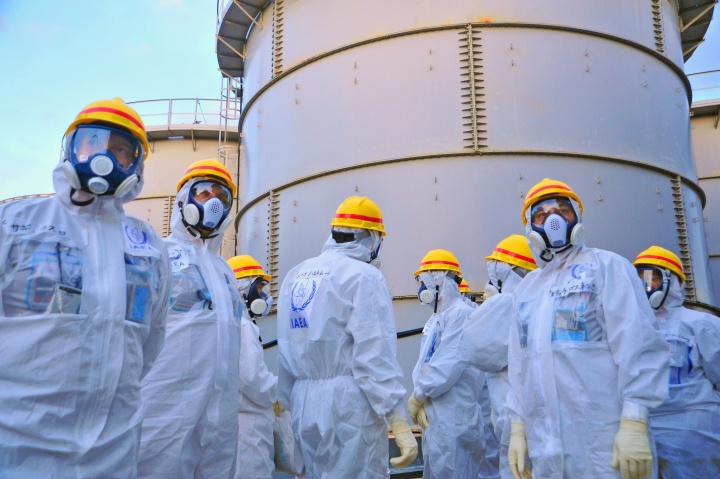Fukushima
A Greater Disaster Looming
Downloads
Fukushima: A Greater Disaster Looming

In Japan there is a developing catastrophe that could affect half the world. News media in the U.S. mostly ignored the alarming news, but Australian news media reported: "Tokyo Electric Power Co. Holdings Inc. (Tepco) said this morning that new fuel leaks have been discovered. The radiation levels—as high as 530 Sieverts per hour—are now the highest they’ve been since 2011 when a tsunami hit the coastal reactor. Newly-discovered radiation levels in one of the Fukushima Daiichi Nuclear Power Plant’s reactors are stunningly high, the Japan Times and others have reported. The space is so radioactive that even a robot couldn’t last two hours, let alone a human” (James Gorman, "Fukushima's Radiation Reaches ‘Unimaginable’ Levels," 9news, Feb. 8, 2017).
The plant currently discharges 300 tons of radioactive contaminated water into the Pacific Ocean each day, which in itself is cause for great concern. But the Fukushima nuclear accident just got a whole lot worse. Combined with the dangerous levels of radiation measured, experts have detected a three- to six-foot wide hole in the floor of the containment structure of reactor number two, allowing decaying fuel material to melt into the ground. This was not supposed to happen.
First-hand experience
I worked for three years as an engineer in nuclear power plants. During that time I spent many days suited up in protective gear in radioactive areas and did development work on the liquid sodium cooled FFTF—the most advanced reactor of its time. I also worked in the Plutonium Finishing Z plant, one of the most guarded and top-secret buildings in the world. This Fukushima news is very serious and a cause for alarm.
A Sievert is a unit of radiation exposure, and exposure to just five Sieverts in a short amount of time has a 50-percent kill rate among humans. Absorbing five Sieverts of radiation over a year’s time is not fatal, but exposure to five Sieverts in just 60 seconds, for example, would almost certainly cause death from radiation poisoning.
Radiation containment breached
The level of radiation measured inside Fukushima reactor two would mean certain death for any human exposed for even a few seconds, and scientists report that it will fry robots used for cleanup in an hour or two. The big problem now is that the melted fuel rods—which are generating this radiation—have apparently bored a hole through the floor of the containment vessel. There is a possibility that they will come into contact with ground water or ocean water. If that happens, it will create radioactive steam explosions resulting in a cloud like the world has perhaps never seen before.
While there is no danger of a nuclear explosion (as one or two have incorrectly reported), there is serious danger of massive amounts of radioactive material being released into the atmosphere if these fuel rods come into contact with water. Since the fuel has burned through the concrete floor, it will be a challenge to contain it—plus no one knows what is going on in the other two burning reactors. How long will it last? Some of that fuel contains plutonium-239, which boasts a half-life of 24,000 years—it will be around for a very long time. No one has a solution so far. Cost estimates for cleanup run as high as $300 billion over the next 40 years.
The daily reports just keep getting more serious. International Business Times reported on Feb. 13: "Radiation levels from the reactors should have faded over time, but Tepco said Thursday levels inside the Fukushima Daiichi plant reached such levels, not even a cleaning robot could survive inside. The previous radiation high, measured one year after the disaster, was 73 Sieverts per hour. February’s measurements showed radiation levels of 650 Sieverts. A single Sievert would be enough to cause radiation sickness in a person while a dose of 10 Sieverts would likely cause death within weeks. ‘I had hoped that the previous results were wrong,’ a government source told The Japan Times. ‘But it is certain that there is an area with high radiation levels inside the reactor’” (Juliana Rose Pignataro, "Fukushima News: 'Unimaginable' Nuclear Reactor Radiation So Destructive, Not Even Robots Can Survive," Feb. 10, 2017).
A world waiting to be delivered
Our Creator God, long ago, knew that mankind would corrupt this physical world and that the creation would need to be delivered—or restored—when Jesus Christ returns.
The apostle Paul wrote to the Church in Rome: "The creation itself also will be delivered from the bondage of corruption into the glorious liberty of the children of God. For we know that the whole creation groans and labors with birth pangs together until now" (Romans 8:21-22). The "bondage of corruption" is more obvious with every passing day.
